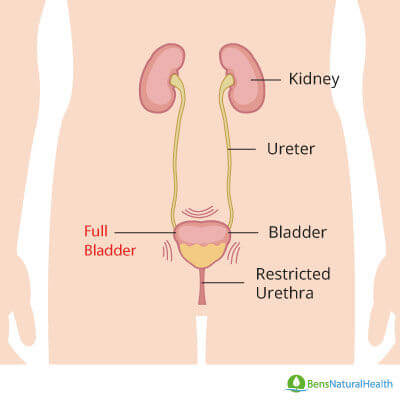- Q: What are the symptoms of urinary retention?
- Q: What are the common causes of urinary retention?
- Q: How is urinary retention diagnosed?
- Q: Are there specific urinary retention conditions that apply only to men?
- Q: What complications can arise from untreated urinary retention?
- Q: How is urinary retention treated?
- Q: What should people understand about the seriousness of urinary retention?
- Additional FAQs on Urinary Retention
- Conclusion
- Our Medical Review Process
- Our Editorial Guidelines
- Medical Disclaimer
- Source
Discussing bladder control problems, even with the doctor, can cause discomfort and embarrassment. Bladder control, however, is an issue that affects far more people than perceived. So bear in mind, if you are unable to urinate properly, you are definitely not alone.
Urinary retention is defined as having great difficulty in completely, or even partially, emptying the bladder. In medical terms, this condition is often referred to as bladder retention, especially when the urine remains trapped in the bladder.
Many people have problems starting urination, as well as keeping the urine volume going, which results in the bladder not being fully drained. The bladder is a very integral part of the body, and when it is not functioning as it should, it is very distressing, and at times, even painful. Fortunately, there are several treatments available, most of which have a good record of success.
We spoke with Dr. Ambardjieva, a leading urologist, to better understand urinary retention, its causes, symptoms, and treatment options. She shared expert insights and supporting research to guide those struggling with this common but often overlooked condition.
All content has been medically reviewed by a medical doctor to ensure accuracy and reliability.
Get Your FREE PSA Lowering Diet Plan!
- Naturally lower PSA levels
- Reduce nighttime trips to the bathroom
- Enjoy better bladder control and urine flow
Q: What are the symptoms of urinary retention?
Doctor Ambardjieva answers: Acute urinary retention happens suddenly and can become life-threatening. You feel like you need to urinate badly, but you can’t go at all. This causes a lot of pain and discomfort in your lower abdomen. Get emergency medical care right away to release the buildup of urine.
Chronic urinary retention occurs over a long period of time. You can urinate, but your bladder doesn’t empty completely. You may not even know you have this condition because you have no symptoms at first.
It’s important to see your doctor promptly if you have one or more of the following symptoms:
- Difficulty starting to urinate
- Inability to pass urine, with only a weak stream or dribble
- Sudden urges to urinate more than usual and difficulty holding it in
- Pain or burning when urinating
- Pain in the lower abdomen and a full-feeling bladder
- Blood in the urine (hematuria)
- Painful blockage in the urethra from stones
- Unusual pelvic pain
- Chronic constipation
- Constant feeling of incomplete bladder emptying
- Difficulty urinating can sometimes be linked to weakened pelvic floor muscles.
These symptoms can result in nerve problems and a weakened bladder muscle. None of these should be ignored; consult a doctor if you experience them.
Q: What are the common causes of urinary retention?
Doctor Ambardjieva answers: Some of the most common causes of non-obstructive urinary retention include:
- Pelvic fractures that damage pelvic organs and nerves
- Medications such as antihistamines and antispasmodics that decrease bladder muscle contractions
- Antidepressants with anticholinergic properties that interfere with urination
- Anesthetics and pain meds post-surgery, which may disrupt nerve signals to the bladder
- Neurological injuries, such as brain or spinal cord trauma
Regardless of the cause, there are treatments available to help manage both acute and chronic bladder retention.

Q: How is urinary retention diagnosed?
Doctor Ambardjieva answers: Diagnosis may involve:
- Urine samples
- Blood tests
- A spinal tap (in some cases)
- Bladder ultrasound
- CT scan or MRI when needed
These tests help determine the cause of urinary retention and guide the treatment approach.
Q: Are there specific urinary retention conditions that apply only to men?
Doctor Ambardjieva answers: Yes, certain male-specific conditions include:
- Enlarged Prostate (BPH)– The major reason men experience urinary retention is due to a problem with the prostate gland. The urethra passes through the prostate from the bladder to the penis where urine is expelled from the body.
- An enlarged prostate, whether due to benign prostatic hyperplasia (BPH), prostate cancer, or temporary swelling from an infection, can press on the urethra and obstruct the normal flow of urine from the body.
- STIs – Can cause swelling and add to blockage
- Urinary blockages – Cause urine to back up, leading to infections
- Scar tissue – From surgery or radiation that constricts the urethra
- Penile infections – Such as those from thrush or STIs, can make urination painful
Whether you’re male or female, obstructive or non-obstructive urinary retention should never be ignored.

Q: What complications can arise from untreated urinary retention?
Doctor Ambardjieva answers: Complications may include:
- Frequent urinary tract infections (UTIs)
- Painful bladder stones
- Long-term bladder damage
- If urine backs up into the kidneys, it can lead to congestion, reducing kidney function. It can also leave you with a high risk of falling prey to chronic kidney disease.
- Urinary retention may also promote the formation of small pouches in the bladder wall, similar to those in the bowel (known as diverticulosis), which can trap bladder stones, causing pain and discomfort. Bacteria present in the pouches can multiply and are liable to cause infections.
Bladder retention, when untreated, can seriously affect overall health.
Q: How is urinary retention treated?
Doctor Ambardjieva answers: Treatment depends on the type and severity of urinary retention.
The impact of urinary retention with its associated issues of urine leaking, or dribbling, can have a dramatic effect on any person’s life.
Fortunately, there are several avenues to treat urinary retention.
Here are some of the recommended treatments for urinary retention:
- Catheter- Acute urinary retention when the urine is almost unable to flow is extremely painful and needs the urgent placement of a catheter in the urethra to clear the blockage and drain the urine. In severe cases, a urethral stent or surgery may be necessary to keep the urethra open.
- Intermittent catheterization– Older people with ongoing problems may require intermittent catheterization. The frequency of the catheterizations depended on fluid intake and bladder capacity. While typically well-tolerated, some individuals with permanently fitted urinary catheters may experience discomfort.
- Alpha-blocker medication– Some men with prostate enlargement (BPH) can be successfully treated with medications to reduce the size of the gland and relieve pressure on the urethra.
- The type of medications that may be used is known as alpha-blockers. They relax the muscles of the bladder neck and the prostate, making it easier for urine to flow more freely from the bladder. However, it should be noted that they can have potential side effects.
- Natural treatments, such as beta-sitosterol and saw palmetto, can also be effective in relieving symptoms of benign prostatic hyperplasia (BPH), though scientific evidence supporting their consistent effectiveness is mixed. To find out more natural alternatives to Flomax, click here. Speak with your urologist about available treatments.
- Surgical removal of obstructive growths – Uterine fibroid growths can press against the bladder and cause frequent urination as well as prevent the bladder from emptying properly. The only treatment that will help is surgical removal of the growths or even a hysterectomy.
- Surgery- Bladder endometriosis (tissue which grows into or onto the outside of the bladder) is usually treated with surgery. The doctor will try to remove all the tissue from inside and outside of the bladder. This should help to relieve the symptoms of frequent urination and painful voiding.
- Bladder lift– Surgery in the form of a bladder lift will help to strengthen weakened bladder muscles, and may potentially improve the signals between the brain and bladder which are needed for urinating.
- Pelvic Exercises– Bladder control therapy, such as pelvic floor exercises, or Kegel exercises, strengthens pelvic muscles. The exercises are easy to do and will benefit both men and women who suffer from urinary retention.
- Lifestyle changes– Some health professionals also recommend lifestyle changes. This includes taking in fewer fluids, following a healthy diet, and if necessary, losing weight. Implementing these simple changes can help with the management of urinary retention.
Treatments are always tailored to suit the needs of the individual. They can only be established once tests have been conducted to get to the root cause of the retention.

Q: What should people understand about the seriousness of urinary retention?
Doctor Ambardjieva answers: Urinary retention is more serious than most people realize. If ignored, it can cause irreversible complications. Neurological conditions like Parkinson’s, multiple sclerosis, stroke, or spinal cord injury can interfere with signals between the bladder and brain, leading to neurogenic bladder.
This may result in bladder therapy with set times to empty the bladder using catheterization, and in many cases, massage of the bladder itself to expel urine.
Management may include timed catheter use or bladder massage. According to the American College of Physicians, urinary retention is underreported and often under-treated, despite affecting millions.
Early detection and proper treatment are key. Most cases are triggered by an underlying condition such as BPH, fibroids, cancer, or nerve damage. Many of these require surgery or long-term management.
Additional FAQs on Urinary Retention
Q: Can holding in urine for long periods cause urinary retention?
Doctor Ambardjieva answers: Yes, holding in urine for long periods can potentially contribute to urinary retention, especially if done repeatedly.
Here’s how:
- Bladder muscle fatigue: Over time, the detrusor muscle (which contracts to expel urine) can become overstretched or weakened, impairing its ability to contract effectively.
- Desensitization of bladder signals: Constantly ignoring the urge to urinate may reduce the sensitivity of the bladder stretch receptors, leading to delayed recognition of fullness and inefficient emptying.
- Risk of functional or overflow retention: In extreme cases, if the bladder becomes overly full and cannot empty properly, it may lead to overflow incontinence or acute urinary retention, especially in people with underlying conditions like BPH or neurological disorders.
Who is most at risk?
- People with prostatic enlargement
- Individuals with neurological conditions
- Those on medications affecting bladder contractility (e.g., anticholinergics)
- Chronic habitual urine holders (e.g., healthcare workers, drivers)
Q: Are there any warning signs of urinary retention during sleep?
Doctor Ambardjieva answers: Yes, frequent nocturia, weak stream, incomplete emptying, leakage, straining, and nighttime abdominal pressure are all potential warning signs of urinary retention during sleep.
1. Nocturia
Waking up more than once per night to urinate, especially regularly, can indicate incomplete bladder emptying or retention
2. Overflow Incontinence (Nocturnal Leakage)
In cases of chronic retention, the bladder may leak small amounts of urine during sleep because it’s overfilled, and a lack of urge triggers before leakage.
3. Weak or Intermittent Stream at Night
Upon rising, you may notice that your urine stream is slow, weak, or starts and stops, classic signs of poor bladder emptying
4. Feeling of Incomplete Bladder Emptying
Even after urinating at night, you may still feel a persistent sense of fullness, as though you haven’t fully emptied your bladder.
5. Straining to Urinate
If you find yourself pushing or straining to begin or complete urination during the night, that can signal outlet obstruction or detrusor weakness
6. Lower Abdominal Discomfort or Pressure
Waking with feelings of heaviness or discomfort in the lower belly may indicate bladder overdistension from retention.

Why It Matters
These symptoms, while often overlooked, can cumulatively suggest chronic urinary retention, when the bladder doesn’t empty fully over time.
Left untreated, this condition may lead to bladder damage, recurrent UTIs, and even kidney issues
If any apply to you, especially when persistent, seeking medical advice is wise.
Q: Can dehydration lead to or mask urinary retention symptoms?
Doctor Ambardjieva answers: Yes, dehydration can both contribute to and mask urinary retention symptoms.
How Dehydration Affects Urinary Retention:
Masking Symptoms: Reduced urine production from dehydration can make it appear as though the bladder is emptying normally, even if retention is present.
This may delay recognition of chronic urinary retention, since there’s simply less urine to accumulate.
Nocturia or urgency may seem absent, giving a false sense of normal voiding patterns.
Contributing to Retention: Concentrated urine from dehydration is more irritating to the bladder, potentially triggering detrusor overactivity followed by underactivity (in long-standing cases).
Bladder underfilling over time may impair normal bladder stretch signaling, leading to poor contraction and functional retention.

Q: Is urinary retention more common after certain types of surgeries?
Doctor Ambardjieva answers: Yes, urinary retention is significantly more common after certain types of surgery, a condition known as postoperative urinary retention (POUR). This complication arises when the bladder is unable to empty completely after surgery, and it’s particularly prevalent following procedures that affect the pelvic region, spine, or those involving regional (spinal or epidural) anesthesia.
Surgeries with a higher risk of urinary retention include:
- Urologic and pelvic surgeries, such as transurethral resection of the prostate (TURP), prostatectomy, and gynecologic procedures like hysterectomy
- Spinal and orthopedic surgeries, especially lumbar spine operations and joint replacements (hip or knee arthroplasty)
- Anorectal surgeries, including hemorrhoidectomy and fistula repair
- Abdominal surgeries are performed under spinal or general anesthesia
- Any major surgery requiring opioid-based pain control, as opioids can suppress bladder muscle activity and increase sphincter tone
The risk is heightened due to several mechanisms: anesthetics and opioids may inhibit detrusor muscle contractility, while postoperative pain and sympathetic nervous system stimulation may prevent normal voiding. In some cases, local swelling or surgical trauma may also lead to mechanical obstruction.
Early identification and monitoring, especially in high-risk procedures, can help prevent complications such as bladder overdistension, infection, or long-term dysfunction.
Q: How does menopause impact urinary retention risk in women?
Doctor Ambardjieva answers: Menopause is a natural biological transition that marks the end of a woman’s reproductive years, but it also brings significant changes to the lower urinary tract that can increase the risk of urinary retention. This condition, where the bladder does not empty fully, can become more common or more difficult to detect in postmenopausal women due to hormonal and structural changes.
One of the primary drivers is estrogen deficiency. Estrogen plays a key role in maintaining the tone and elasticity of the bladder neck, urethra, and pelvic floor tissues. After menopause, declining estrogen levels lead to urogenital atrophy, thinning of the urethral mucosa, and weakening of supportive tissues. These changes may contribute to impaired voiding and decreased urethral resistance.
In addition, pelvic floor muscle weakening, common with age and hormonal shifts, can disrupt the coordinated effort needed for effective bladder emptying. This, combined with potential detrusor underactivity (reduced bladder muscle contractility), increases the risk of underactive bladder syndrome and chronic retention.
Another contributing factor is the increased incidence of pelvic organ prolapse (POP) in postmenopausal women, particularly cystocele (bladder prolapse), which can cause mechanical obstruction of the urinary outflow tract. This can further impede complete voiding and lead to overflow symptoms.
Complicating the picture, postmenopausal women may also take medications that affect bladder function (such as anticholinergics, sedatives, or antihistamines) or have comorbid conditions like diabetes or neurological disorders that contribute to bladder dysfunction.
In short, menopause creates a constellation of anatomical, hormonal, and functional changes that can elevate a woman’s risk for urinary retention. Awareness and proactive evaluation are essential, especially in those experiencing persistent voiding difficulty, weak stream, or recurrent urinary tract infections.
Q: Can stress and anxiety contribute to urinary retention?
Doctor Ambardjieva answers: While urinary retention is often associated with physical causes such as prostate enlargement or neurological disorders, emerging evidence highlights the important role of psychological factors, including stress and anxiety. In some individuals, particularly when no clear physical cause is found, stress can significantly impair normal bladder function, leading to what’s known as functional or psychogenic urinary retention.
When a person is under stress or experiencing anxiety, the autonomic nervous system becomes activated, particularly the sympathetic branch, which tightens the bladder neck and urethral sphincter. This physiological response, while helpful in “fight-or-flight” situations, can interfere with the normal urge and ability to void. Simultaneously, the detrusor muscle, responsible for bladder contractions, may become inhibited, making urination difficult or even impossible in high-stress moments.
This response is especially pronounced in individuals with generalized anxiety disorder, panic attacks, or a specific condition called paruresis, also known as shy bladder syndrome, where the fear of urinating in public restrooms causes the bladder to “lock up.” In other cases, patients may experience acute urinary retention during periods of emotional trauma or distress, such as after surgery, childbirth, or hospitalization.
Because stress-related urinary retention often lacks a structural cause, it is usually diagnosed by exclusion, once physical and neurological contributors have been ruled out. Treatment may involve psychological counseling, pelvic floor physiotherapy, mindfulness techniques, and occasionally anxiolytic medications in carefully selected patients.
In short, the bladder and brain are intimately connected, and mental health can have a tangible impact on urological function. Recognizing stress as a possible cause of urinary retention can help prevent unnecessary interventions and lead to more targeted, holistic care.
Conclusion
Urinary retention can be a distressing condition, but it’s also highly treatable with the right approach. Whether caused by an underlying medical issue or lifestyle factors, early diagnosis and proper care can make a significant difference. With expert insights from the doctor and evidence-based treatments available, those affected don’t have to manage it alone, support and solutions are within reach.
Our Medical Review Process
At Ben’s Natural Health, we’re committed to providing accurate and trustworthy health information. All content is written by licensed medical experts and reviewed regularly, every 12 to 24 months, to ensure it reflects the latest research. We rely solely on peer-reviewed studies from respected journals and include complete citations and links to support our content’s reliability. For more details, visit our page on medical review procedures and research standards.
Our Editorial Guidelines
Ben’s Natural Health has delivered science-supported natural health insights for over 25 years. Our editorial process follows strict standards to ensure accuracy and credibility. Articles are authored by qualified professionals, physicians, dietitians, fitness specialists, and surgeons, and undergo independent fact-checking. Each article includes contributor credentials and bios for full transparency.To learn more, explore our editorial guidelines.
Medical Disclaimer
The information provided on this site is meant for general education and informational use. It is not a replacement for professional medical advice, diagnosis, or treatment. Though our content is created and reviewed by licensed professionals, it may not apply to your personal health needs. Always seek guidance from a healthcare provider for any medical concerns. Never delay care based on the information found here. Use of this content is entirely at your own discretion.








